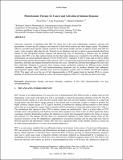Photodynamic Therapy for Cancer and Activation of Immune Response
Author(s)
Mroz, Pawel; Huang, Ying-Ying; Hamblin, Michael R.
DownloadMroz-2010-Photodynamic therapy.pdf (508.7Kb)
PUBLISHER_POLICY
Publisher Policy
Article is made available in accordance with the publisher's policy and may be subject to US copyright law. Please refer to the publisher's site for terms of use.
Terms of use
Metadata
Show full item recordAbstract
Anti-tumor immunity is stimulated after PDT for cancer due to the acute inflammatory response, exposure and presentation of tumor-specific antigens, and induction of heat-shock proteins and other danger signals. Nevertheless effective, powerful tumor-specific immune response in both animal models and also in patients treated with PDT for cancer, is the exception rather than the rule. Research in our laboratory and also in others is geared towards identifying reasons for this sub-optimal immune response and discovering ways of maximizing it. Reasons why the immune response after PDT is less than optimal include the fact that tumor-antigens are considered to be self-like and poorly immunogenic, the tumor-mediated induction of CD4+CD25+foxP3+ regulatory T-cells (T-regs), that are able to inhibit both the priming and the effector phases of the cytotoxic CD8 T-cell anti-tumor response and the defects in dendritic cell maturation, activation and antigen-presentation that may also occur. Alternatively-activated macrophages (M2) have also been implicated. Strategies to overcome these immune escape mechanisms employed by different tumors include combination regimens using PDT and immunostimulating treatments such as products obtained from pathogenic microorganisms against which mammals have evolved recognition systems such as PAMPs and toll-like receptors (TLR). This paper will cover the use of CpG oligonucleotides (a TLR9 agonist found in bacterial DNA) to reverse dendritic cell dysfunction and methods to remove the immune suppressor effects of T-regs that are under active study.
Date issued
2010-02Department
Harvard University--MIT Division of Health Sciences and TechnologyJournal
Proceedings of SPIE--the International Society for Optical Engineering; v. 7565
Publisher
SPIE
Citation
Mroz, Pawel, Ying-Ying Huang, and Michael R. Hamblin. “Photodynamic therapy for cancer and activation of immune response.” Biophotonics and Immune Responses V. Ed. Wei R. Chen. San Francisco, California, USA: SPIE, 2010. 756503-8. ©2010 COPYRIGHT SPIE--The International Society for Optical Engineering.
Version: Final published version
ISSN
0277-786X
Keywords
photodynamic therapy, anti-tumor immunity, regulatory T-cells, CpG oligonucleotides, low dose cyclophosphamide